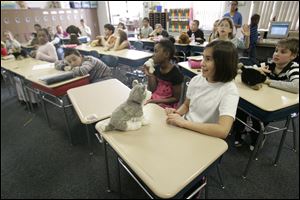
Holland fourth graders on the trail with Iditarod mushers
3/17/2010
Tatelynn Linares, foreground, and the others in the Holland Elementary class with their stuffed animals track the Iditarod.
A gray-and-white husky, its nose pressed against a classroom desk, keeps Tatelynn Linares company in Ohio as she cheers on canine athletes racing toward a finish line in Alaska.
"It would be kind of scary, and tiring, too, I think," the 10-year-old said as she talked about what is dubbed the "Last Great Race."
At Holland Elementary School, where Tatelynn and other fourth-graders are honing math, reading, writing, and other skills as they participate in lessons tied to the Iditarod, a pack of paper dogs has shifted leads daily during the race. Strands of red yarn keep the dogs in line on a wall in the school's hallway near a display of student-made Musher Trading Cards.
In the days leading up to the Iditarod, students selected names from a pool of mushers who are willing to be part of educational programs linked to the race from Anchorage to Nome, and the students have kept close tabs on them since. Fourth-grade teacher Susan Hanna introduced the Iditarod-related lessons this year after she witnessed the keen interest her son Ross showed last year when his sixth-grade class at McCord Junior High School in Sylvania tackled similar studies.
On a recent morning at the Holland school, before the big reveal of current standings, the class adds, subtracts, and multiplies numbers of booties. When Mrs. Hanna asks why Iditarod dogs wear booties, student Theresa Schmidlin answers that they keep the dogs' feet warm and prevent infections.
According to the Iditarod Web site, the booties protect dogs' feet from the sharp-edged snow of the trail.
The trail crosses jagged mountain ranges, frozen rivers, dense forests, desolate tundra, and miles of windswept coast.
The students write letters to the sled-dog racers and include stamped, self-addressed envelopes, and students are eager to get replies.
The race started March 6. Mrs. Hanna said it takes about eight days for some contestants to complete the course and up to 15 days for others.
A few students experienced disappointment when their mushers dropped out of the race. Marisa Legeza, 9, said she will pick another sled-dog racer to follow during the race because her musher Kathleen Frederick of Willow, Alaska, dropped out.
During their Iditarod studies, many desks have been adorned with stuffed dogs, some sitting up, others flopping like a "dog in basket" - musher-speak for a tired or injured dog carried in a sled.
Students filled in A-to-Z vocabulary word sheets as the race progressed, such as "amateur," a word that crept into the conversation as students talked about rookie mushers.
Push pins dot a map at the front of the classroom, tracking the racers' progress. Gavin Weisner, 9, got to push in a pin on the recent day when a reporter visited because he was Top Dog - his musher, Hugh Neff of Toke, Alaska, was in the lead.
"He was born in Tennessee. He has raced before," Gavin said about Mr. Neff.
On Mr. Neff's Musher Trading Card, it's penciled in that he "worked as a golf caddy person," and that "Racing is an excuse to play with our beloved beasts all over the North."
To mark the finish of the race, students will trek to the Springfield High School, where, using a recipe, measuring cups and spoons, and select ingredients, will make dog biscuits. The biscuits will be donated to the Toledo Area Humane Society, Mrs. Hanna said, and students with pet dogs at home will take home some samples as well.